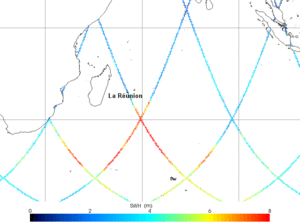Southern Swell in the Indian Ocean
On the evening of May 12, 2007, a series of very high waves broke over Reunion Island, in the Indian Ocean, a phenomenon that was repeated during May 14 to 15 night. The waves did numerous damages, on Reunion and neighbouring islands; several people disappeared. Those waves reached on May 12 maximum heights of 11.3 m (6.4 m of significant wave height), and 8 m on May 14 to 15 night, as measured by wave gauges.
An alert was emitted by Météo France on Friday, 11, morning, and re-evaluated on Saturday, 12, with an higher swell.
This phenomenon, called "southern swell" is due to an heavy storm around 40°S (the famous 'roaring forties'), South of Africa. The storm engendered swell, which propagated in the Indian Ocean at about 1000 km/day, going over the Reunion, in a region where low winds do not disrupt the swell.
Lasting long enough, and with a rather large extension, it has been observed by multiple altimeter tracks. The 1st swell caused waves higher than 15 m (significant wave heights). Jason-1 significant wave heights are thus around 10 m South of the island on May 12.
Altimetric data from Jason-1 and Envisat helped better forecasting of this phenomenon by being assimilated in Météo France sea state forecast models.







